Free PDF download of NCERT Exemplar for Class 12 Maths Chapter 8 - Application of Integrals
Free PDF download of NCERT Exemplar for Class 12 Maths Chapter 8 - ApplicationOf Integrals solved by expert Maths teachers on vedantu.com as per NCERT (CBSE) Book guidelines. All Chapter 8 - Application Of Integrals Exercise questions with solutions to help you to revise complete syllabus and score more marks in your Examinations.
NCERT Exemplar for Class 12 Maths Chapter 8 - Application of Integrals is available at Vedantu’s official website i.e. vedantu.com. The Exemplar is available in PDF form for the students to practice and revise the concepts. The Exemplar PDF consists of problems and additional questions that give an efficient preparation for the students to boost their scores in the Examinations. This PDF will enhance the advanced knowledge of the respective subject which is important from the Exam’s point of view. Students constantly following the Exemplar will notice the change in the question-solving pattern and recognize the concepts they have met earlier but found them tough. The NCERT Exemplar for Class 12 Maths, Chapter 8 Applicationof Integrals has been developed and designed in such a manner that will increase the thinking process of students to solve the Exercises related to the Chapter. Also, the Exemplar is designed by the expert faculty of Vedantu on the latest guidelines and syllabus pattern advised by the Central Board of Secondary education.
Access NCERT Exemplar Solutions for Grade 12 Mathematics Chapter 8: Application of Integrals
Solved Examples
Short Answers
1. Find the area of the curve $y=\sin ~x$ between 0 and π.
Ans: We have,
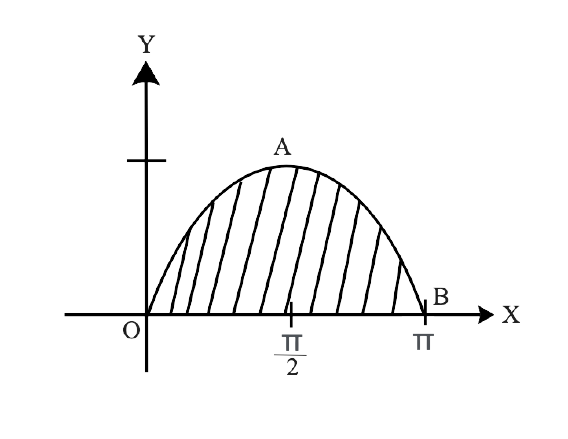
Area OAB $=\mathop{\int }_{0}^{\pi }ydx=\mathop{\int }_{0}^{\pi }\sin ~xdx$
$=\left| -\cos ~x \right|_{0}^{\pi }$
$\text{=cos0 }\!\!~\!\!\text{ -- }\!\!~\!\!\text{ cos }\!\!\pi\!\!\text{ }\!\!~\!\!\text{ = }\!\!~\!\!\text{ 2 }\!\!~\!\!\text{ sq }\!\!~\!\!\text{ units}\text{.}$
2. Find the area of the region bounded by the curve $a{{y}^{2}}={{x}^{3}}$, the y-axis and the lines y = a and y = 2a.
Ans: We have
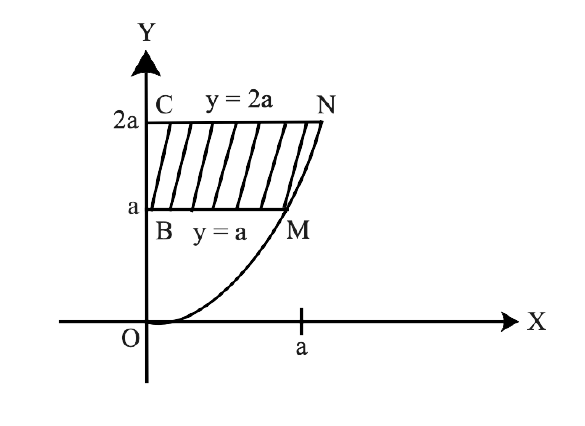
Area BMNC \[=\mathop{\int }_{a}^{2a}\text{xdy}=\mathop{\int }_{a}^{2a}{{\text{a}}^{\frac{\text{1}}{\text{3}}}}{{\text{y}}^{\frac{\text{2}}{\text{3}}}}\text{dy}\]
$\text{=}\frac{\text{3}{{\text{a}}^{\frac{\text{1}}{\text{3}}}}}{\text{5}}\left| {{\text{y}}^{\frac{\text{5}}{\text{3}}}} \right|_{\text{a}}^{\text{2a}}$
$\text{=}\frac{\text{3}{{\text{a}}^{\frac{\text{1}}{\text{3}}}}}{\text{5}}\left| {{\left( \text{2a} \right)}^{\frac{\text{5}}{\text{3}}}}\text{-}{{\text{a}}^{\frac{\text{5}}{\text{3}}}} \right|_{{}}^{{}}$
$\text{=}\frac{\text{3}{{\text{a}}^{\frac{\text{1}}{\text{3}}}}{{\text{a}}^{\frac{\text{5}}{\text{3}}}}}{\text{5}}\left| {{\text{2}}^{\frac{\text{5}}{\text{3}}}}\text{-1} \right|_{{}}^{{}}$
$\text{=}\frac{\text{3}{{\text{a}}^{\text{2}}}}{\text{5}}\left| \text{2}\text{.}{{\text{2}}^{\frac{\text{1}}{\text{3}}}}\text{-1} \right|$sq. units
3. Find the area of the region bounded by the parabola ${{y}^{2}}=2x$ and the straight line x – y = 4.
Ans:
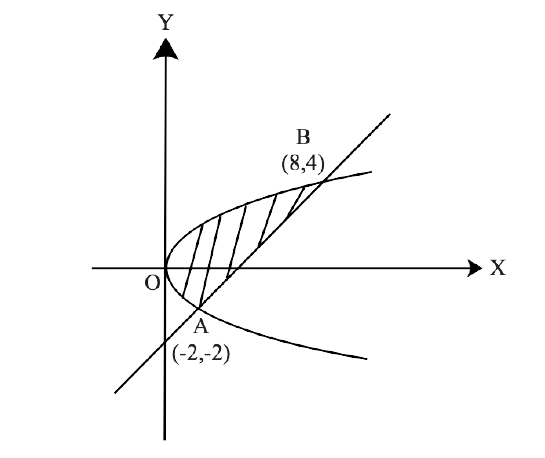
The intersecting points of the given curves are obtained by solving the equations x – y = 4 and ${{y}^{2}}=2x$ for x and y. We have ${{y}^{2}}=8+2y$ i.e., (y – 4) (y + 2) = 0 which gives y = 4, –2 and x = 8, 2. Thus, the points of intersection are (8, 4), (2, –2). Hence
Area \[=\mathop{\int }_{-2}^{4}\left( \text{4+y-}\frac{{{\text{y}}^{\text{2}}}}{\text{2}} \right)\text{dy}\]
$\text{=}\left| \text{4y+}\frac{{{\text{y}}^{\text{2}}}}{\text{2}}\text{-}\frac{{{\text{y}}^{\text{3}}}}{\text{6}} \right|_{\text{-2}}^{\text{4}}\text{=18 }\!\!~\!\!\text{ sq}\text{. }\!\!~\!\!\text{ units}$
4. Find the area of the region bounded by the parabolas ${{\text{y}}^{\text{2}}}$ = 6x and ${{x}^{2}}$ = 6y.
Ans:
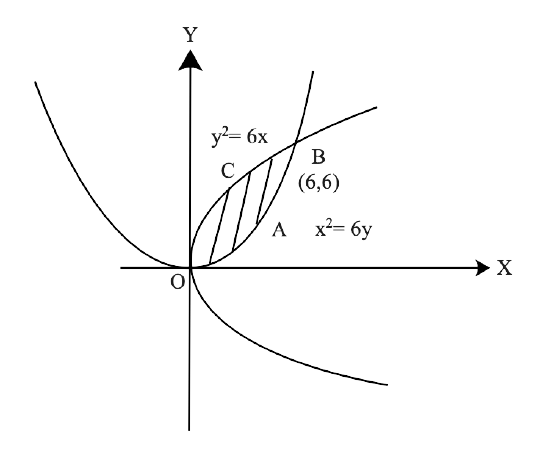
The intersecting points of the given parabolas are obtained by solving these
equations for x and y, which are 0(0, 0) and (6, 6). Hence
Area OABC $=\mathop{\int }_{0}^{6}\left( \sqrt{\text{6x}}\text{-}\frac{{{\text{x}}^{\text{2}}}}{\text{6}} \right)\text{dx=}\left| \text{2}\sqrt{\text{6}}\frac{{{\text{x}}^{\text{3/2}}}}{\text{3}}\text{-}\frac{{{\text{x}}^{\text{3}}}}{\text{18}} \right|_{\text{0}}^{\text{6}}$
$=\left| 2\sqrt{6}\frac{{{6}^{3/2}}}{3}-\frac{{{6}^{3}}}{18} \right|=12~sq.~units$
5. Find the area enclosed by the curve x = 3 cost, y = 2 sint.
Ans: Eliminating t as follows: x = 3 cost, y = 2 sin t ⇒ cos t = $\frac{x}{3}$ , sin t = $\frac{y}{2}$ , we obtain
$\frac{{{x}^{2}}}{9}+\frac{{{y}^{2}}}{4}=1$,
Which is the equation of an ellipse.
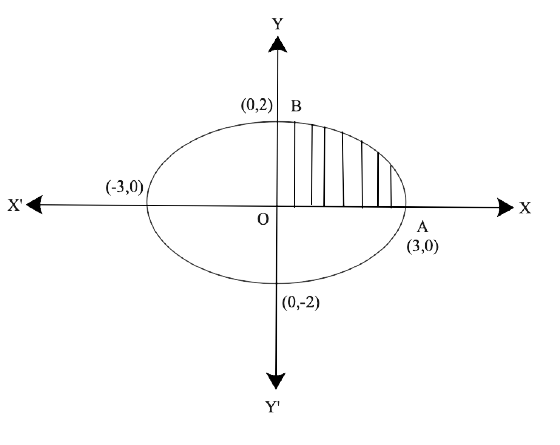
From figure we get:
The required area $=4\mathop{\int }_{0}^{3}\frac{2}{3}\sqrt{9-{{x}^{2}}}dx$
$=\frac{8}{3}\left[ \frac{x}{2}\sqrt{9-{{x}^{2}}}+\frac{9}{2}si{{n}^{-1}}\frac{x}{3} \right]_{0}^{3}=6\pi ~sq.~units$
Long Answers
6. Find the area of the region included between the parabola $y=\frac{3{{x}^{2}}}{4}$ and the line 3x – 2y + 12 = 0.
Ans: Solving the equations of the given curves $y=\frac{3{{x}^{2}}}{4}$ and 3x – 2y + 12 = 0, we get 3${{x}^{2}}$ – 6$x$ – 24 = 0 ⇒ (x – 4) (x + 2) = 0
⇒ x = 4, x = –2 which give y = 12, y = 3
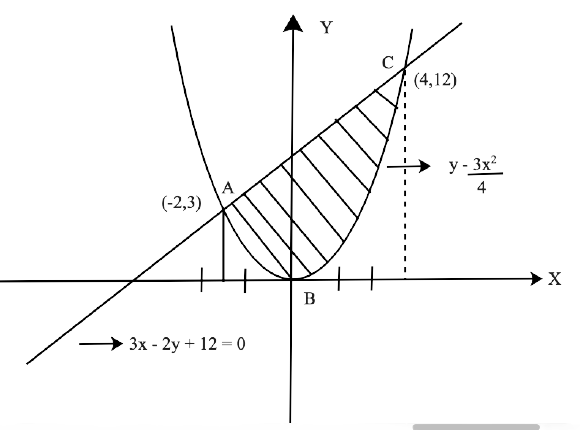
From Fig, the required area = area of ABC
$=\mathop{\int }_{-2}^{4}\left( \frac{12+3x}{2} \right)dx-\mathop{\int }_{-2}^{4}\left( \frac{3{{x}^{2}}}{4} \right)dx$
$=\left( 6x+\frac{3{{x}^{2}}}{4} \right)_{-2}^{4}-\left| \frac{3{{x}^{3}}}{12} \right|_{-2}^{4}=27~sq.units$
7. Find the area of the region bounded by the curves x = a${{t}^{2}}$ and y = 2at between the ordinates corresponding to t = 1 and t = 2.
Ans: Given that x = a${{t}^{2}}$ ...(i), y = 2at ...(ii) ⇒ t = $\frac{y}{2a}$ putting the value of t in (i), we get ${{y}^{2}}$ = 4ax
Putting t = 1 and t = 2 in (i), we get x = a, and x = 4a
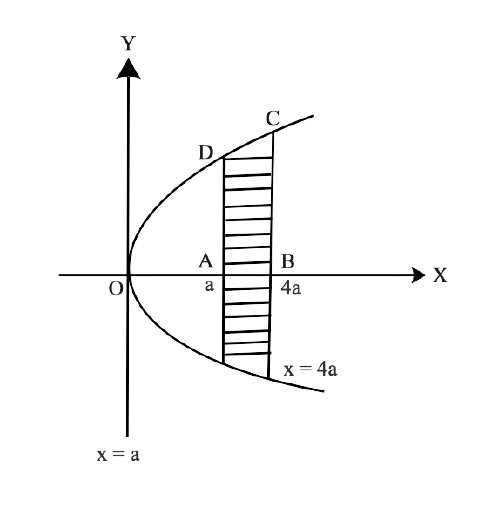
Required area = 2 area of ABCD
$=2\mathop{\int }_{a}^{4a}ydx=2\times 2\mathop{\int }_{a}^{4a}\sqrt{ax}dx$
$=8\sqrt{a}\left| \frac{{{x}^{3/2}}}{3} \right|_{a}^{4a}=\frac{56}{3}{{a}^{2}}~sq.units$
8. Find the area of the region above the x-axis, included between the parabola ${{y}^{2}}$ = ax and the circle ${{x}^{2}}$ + ${{y}^{2}}$ = 2ax.
Ans: Solving the given equations of curves, we have ${{x}^{2}}$ + ax = 2ax or x = 0, x = a, which give y = 0, y = ± a
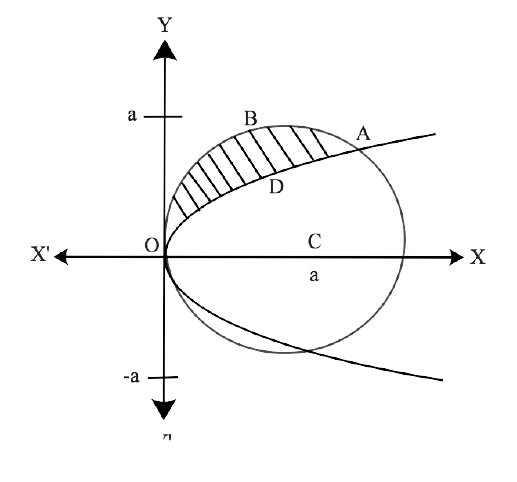
From fig -
Area ODAB $=\mathop{\int }_{0}^{a}\left( \sqrt{2ax-{{x}^{2}}}-\sqrt{ax} \right)dx$
Let x = 2a $si{{n}^{2}}\theta $. Then dx = 4a sinθ cosθ dθ and x = 0, ⇒ θ = 0, x = a ⇒ θ = $\frac{\pi }{4}.$
Again, $\mathop{\int }_{0}^{a}\left( \sqrt{2ax-{{x}^{2}}} \right)dx$
$=\mathop{\int }_{0}^{\frac{\pi }{4}}\left( 2a.sin~\theta .cos~\theta \right)\left( 4a.sin~\theta .cos~\theta \right)d\theta $
$={{a}^{2}}\mathop{\int }_{0}^{\frac{\pi }{4}}\left( 1-cos~4\theta \right)d\theta ={{a}^{2}}\left( \theta -\frac{sin~4\theta }{4} \right)_{0}^{\frac{\pi }{4}}=\frac{\pi }{4}{{a}^{2}}$
Furthermore,
$\mathop{\int }_{0}^{a}\left( \sqrt{ax} \right)dx=\sqrt{a}\frac{2}{3}\left( {{x}^{\frac{3}{2}}} \right)_{0}^{a}=\frac{2}{3}{{a}^{2}}$
Thus the required area = $\frac{\pi }{4}{{a}^{2}}$ – $\frac{2}{3}{{a}^{2}}$ = ${{a}^{2}}\left( ~\frac{\pi }{4}~\frac{2}{3} \right)$ sq units
9. Find the area of a minor segment of the circle ${{x}^{2}}+{{y}^{2}}={{a}^{2}}$ cut off by the line x = $\frac{a}{2}$.
Ans: Solving the equation ${{x}^{2}}+{{y}^{2}}={{a}^{2}}$ and x = $\frac{a}{2}$, we obtain their points of intersection which are $\left( \frac{a}{2},~\sqrt{3}\frac{a}{2} \right)~and~\left( \frac{a}{2},~-\sqrt{3}\frac{a}{2} \right).$
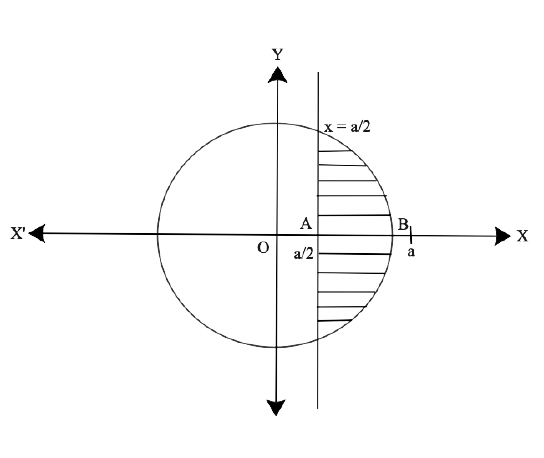
Hence, from fig, we get -
Required area = 2 $\times $ area of OAB $=2\mathop{\int }_{a/2}^{a}\sqrt{{{a}^{2}}-{{x}^{2}}}dx$
$=2\left[ \frac{x}{2}\sqrt{{{a}^{2}}-{{x}^{2}}}+\frac{{{a}^{2}}}{2}si{{n}^{-1}}\frac{x}{a} \right]_{a/2}^{a}$
$=2\left[ \frac{{{a}^{2}}}{2}\frac{\pi }{2}-\frac{a}{4}.a.\frac{\sqrt{3}}{2}-\frac{{{a}^{2}}}{2}.\frac{\pi }{6} \right]_{{}}^{{}}$
$=\frac{{{a}^{2}}}{12}\left( 6\pi -3\sqrt{3}-2\pi \right)$
$=\frac{{{a}^{2}}}{12}\left( 4\pi -3\sqrt{3} \right)~sq.units$
Objective type questions
Choose the correct answer from the given four options in each of the Examples 10 to 12.
10. The area enclosed by the circle ${{x}^{2}}+{{y}^{2}}=2$ is equal to
(A) 4$\pi $ sq. units
(B) $2\sqrt{2}\pi $ sq. units
(C) 4${{\pi }^{2}}$ sq. units
(D) $2\pi $ sq. units
Ans: Correct answer is (D); since Area $=4\mathop{\int }_{0}^{\sqrt{2}}\sqrt{2-{{x}^{2}}}dx$
$=4\left[ \frac{x}{2}\sqrt{{{a}^{2}}-{{x}^{2}}}+\frac{{{a}^{2}}}{2}si{{n}^{-1}}\frac{x}{a} \right]_{0}^{\sqrt{2}}=2\pi ~sq.units$
11. The area enclosed by the ellipse $\frac{{{x}^{2}}}{{{a}^{2}}}+\frac{{{y}^{2}}}{{{b}^{2}}}=1$ is equal to
(A) ${{\pi }^{2}}ab$
(B) $\pi ab$
(C) $\pi {{a}^{2}}b$
(D) $\pi a{{b}^{2}}$
Ans: Correct answer is (B); since Area $=4\mathop{\int }_{0}^{a}\frac{b}{a}\sqrt{{{a}^{2}}-{{x}^{2}}}dx$
$=4\frac{b}{a}\left[ \frac{x}{2}\sqrt{{{a}^{2}}-{{x}^{2}}}+\frac{{{a}^{2}}}{2}si{{n}^{-1}}\frac{x}{a} \right]_{0}^{a}=\pi ab~sq.units$
12. The area of the region bounded by the curve $y={{x}^{2}}$ and the line y = 16.
(A) $\frac{32}{3}$
(B) $\frac{256}{3}$
(C) $\frac{64}{3}$
(D ) $\frac{128}{3}$
Ans: Correct answer is (B); since Area $=2\mathop{\int }_{0}^{16}\sqrt{y}dy$
$=2\left( \frac{{{y}^{\frac{3}{2}}}}{\frac{3}{2}} \right)_{0}^{16}=\frac{4}{3}\left( {{16}^{\frac{3}{2}}}-0 \right)$
$=\frac{4}{3}\left( {{4}^{2\times \frac{3}{2}}}-0 \right)$
$=\frac{{{4}^{4}}}{3}=\frac{256}{3}~sq.units$
Fill in the blanks in each of the Examples 13 and 14.
13. The area of the region bounded by the curve $x={{y}^{2}}$ , y-axis and the line y=3 and y = 4 is _______.
Ans: since Area $=\mathop{\int }_{3}^{4}xdy=\mathop{\int }_{3}^{4}{{y}^{2}}dy$
$=\left( \frac{{{y}^{3}}}{3} \right)_{3}^{4}=\left( \frac{{{4}^{3}}}{3}-\frac{{{3}^{3}}}{3} \right)_{{}}^{{}}$
$=\left( \frac{64}{3}-\frac{27}{3} \right)=\frac{37}{3}~sq.units$
14. The area of the region bounded by the curve y =$~{{x}^{2}}+x$, x-axis and the line x = 2 and x = 5 is equal to ________.
Ans: since Area $=\mathop{\int }_{2}^{5}ydx=\mathop{\int }_{2}^{5}\left( {{x}^{2}}+x \right)dx$
$=\left( \frac{{{x}^{3}}}{3} \right)_{2}^{5}+\left( \frac{{{x}^{2}}}{2} \right)_{2}^{5}=\left( \frac{{{5}^{3}}}{3}-\frac{{{2}^{3}}}{3} \right)_{{}}^{{}}+\left( \frac{{{5}^{2}}}{2}-\frac{{{2}^{2}}}{2} \right)$
$=\left( \frac{125}{3}-\frac{8}{3} \right)+\left( \frac{25}{2}-\frac{4}{2} \right)$
$=\left( \frac{117}{3} \right)+\left( \frac{21}{2} \right)=\frac{234~+~63}{6}=\frac{297}{6}~sq.units$
Short Answer Questions
1. Find the area of the region bounded by the curves ${{y}^{2}}$ = 9x, y = 3x.
Ans: We have ${{y}^{2}}$ = 9x, y = 3x.
$\Rightarrow ~{{\left( 3x~ \right)}^{2}}=~9x$
$\Rightarrow ~9{{x}^{2}}-~9x=~0$
$\Rightarrow ~9x\left( x-~1 \right)=~0$
$\Rightarrow $ x = 0,1
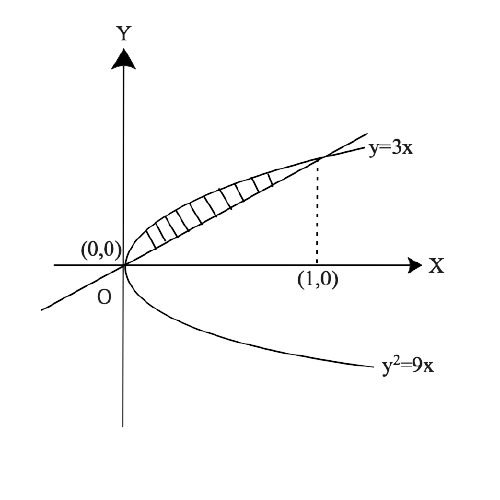
Therefore, required area = $\mathop{\int }_{0}^{1}\sqrt{9x}dx~-\mathop{\int }_{0}^{1}3x~dx~$
$\Rightarrow $ 3 $\mathop{\int }_{0}^{1}{{x}^{\frac{1}{2}}}$dx - 3$\mathop{\int }_{0}^{1}x~dx$
$\Rightarrow $ 3 $\left[ \frac{{{x}^{\frac{3}{2}}}}{\frac{3}{2}} \right]_{0}^{1}$- 3 $\left[ \frac{{{x}^{2}}}{2} \right]_{0}^{1}$
$\Rightarrow $ 3 ($\frac{2}{3}-0)$ - 3 ($\frac{1}{2}-0)$
$\Rightarrow $ 2- $\frac{3}{2}$ = $\frac{1}{2}$ units
2. Find the areaof the region bounded by the parabola ${{y}^{2}}$ = 2px,$~{{x}^{2}}$ = 2py.
Ans: We have ${{y}^{2}}$ = 2px, ${{x}^{2}}$ = 2py.
y = $\sqrt{2px}$
$\Rightarrow $ ${{x}^{2}}$= 2p$\sqrt{2px}$
$\Rightarrow $ ${{x}^{4}}$ = 4 ${{p}^{2}}$(2px)
$\Rightarrow $ ${{x}^{4}}$ = 8${{p}^{3}}$x
$\Rightarrow $ ${{x}^{4}}$ - 8${{p}^{3}}$x = 0
$\Rightarrow $ $x~({{x}^{3}}$ - 8${{p}^{3}}$) =0
$\Rightarrow $ x =0, 2p
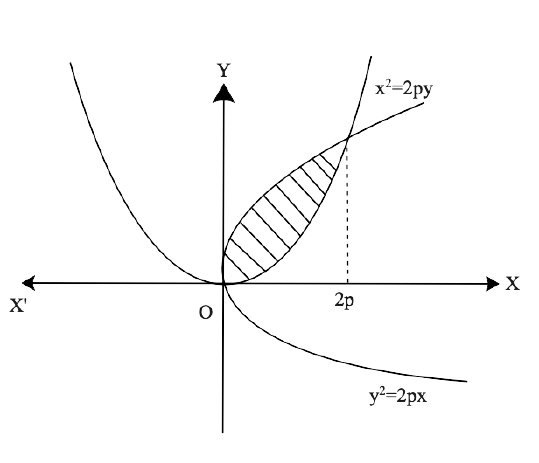
Required area = $\mathop{\int }_{0}^{2p}\sqrt{2px}$ dx - $\mathop{\int }_{0}^{2p}\frac{{{x}^{2}}}{2p}$ dx
= $\sqrt{2p}$ $\mathop{\int }_{0}^{2p}\sqrt{x}$ dx - $\frac{1}{2p}\mathop{\int }_{0}^{2p}{{x}^{2}}$ dx
=$\sqrt{2p~}\left[ \frac{2~{{\left( x \right)}^{\frac{3}{2}}}}{3} \right]_{0}^{2p}$- $\frac{1}{2p}\left[ \frac{{{\left( x \right)}^{3}}}{3} \right]_{0}^{2p}$
= $\sqrt{2p~}\left[ \frac{2~{{\left( 2p \right)}^{\frac{3}{2}}}}{3}-0 \right]$- $\frac{1}{2p}$[$\frac{{{\left( 2p \right)}^{3}}}{3}$ -0]
= $\sqrt{2p~}$($\frac{2}{3}.2\sqrt{2}$ ${{p}^{\frac{3}{2}}}$)- $\frac{1}{2p}$($\frac{1}{3}$.8 ${{p}^{3}})$
= $\frac{4\sqrt{2}}{3}$.$\sqrt{2}~{{\text{p}}^{\text{2}}}$- $\frac{8}{6}{{p}^{2}}$
= $\frac{8}{6}{{p}^{2}}$
= $\frac{4}{6}{{p}^{2}}$ sq unit
3. Find the area of the region bounded by the curve y = ${{x}^{3}}$ and y = x + 6 and
x = 0.
Ans: We have, y = ${{x}^{3}}$ and y = x + 6 and x = 0.
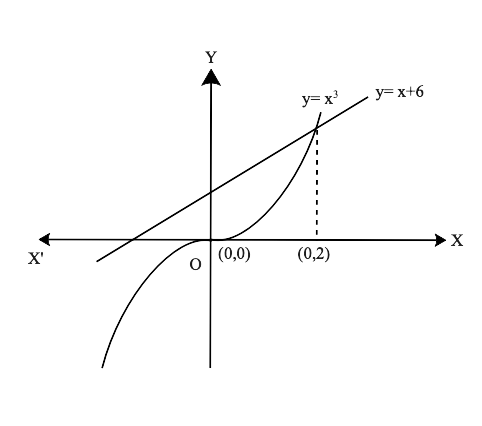
Therefore, ${{x}^{3}}$ = x + 6
$\Rightarrow $ ${{x}^{3}}$ - x = 6
$\Rightarrow $ ${{x}^{3}}$ - x - 6 = 0
$\Rightarrow $ ${{x}^{2}}\left( x-2 \right)$+ 2x (x-2) + 3 (x-2)= 0
$\Rightarrow $ (x-2) (${{x}^{2}}$+ 2x +3) = 0
$\Rightarrow $ x = 2, With two imaginary points
Therefore, required area of shaded region= $\mathop{\int }_{0}^{2}(x~+6~-{{x}^{3}}$) dx
= $[\frac{{{x}^{2}}}{2}+6x~-\frac{{{x}^{4}}}{2}_{{}}^{{}}]_{0}^{2}$
= [ $\frac{{{2}^{2}}}{2}$ + 6(2) - $\frac{{{2}^{4}}}{2}$-0]
= [2 + 12 -4] = 10 sq units
4. Find the area of the region bounded by the curve ${{y}^{2}}$ = 4x, ${{x}^{2}}$= 4y.
Ans: Given equations of curves are
${{y}^{2}}$ = 4x ---------- (i)
and ${{x}^{2}}$= 4y.------- (ii)
$\Rightarrow $ $\frac{{{x}^{2}}}{4}$ = 4x
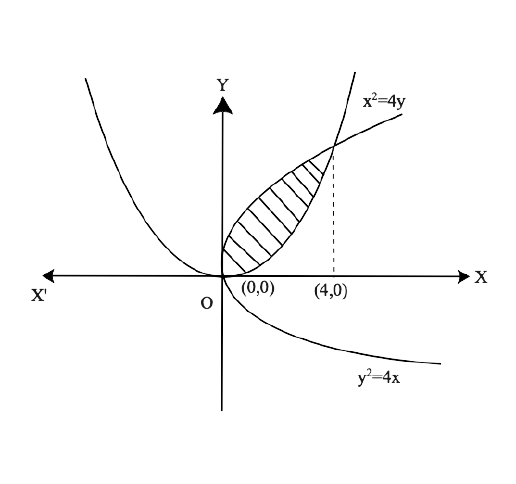
$\Rightarrow $ $\frac{{{x}^{2}}}{4.4}$ = 4x
$\Rightarrow $ ${{x}^{4}}$= 64 x
$\Rightarrow $ ${{x}^{4}}$- 64 x= 0
$\Rightarrow $ x(${{x}^{3}}$- 64) =0
$\Rightarrow $ x (${{x}^{3}}$-${{4}^{3}}$)=0
$\Rightarrow $ x = 4 ,0
Therefore, area of shaded region A = $\mathop{\int }_{0}^{4}$($\sqrt{4x}$ - $\frac{{{x}^{2}}}{4}~)~dx$
= $\mathop{\int }_{0}^{4}$($2\sqrt{x}$ - $\frac{{{x}^{2}}}{4}~)~dx$
= $\left[ \frac{2~{{x}^{\frac{3}{2}}}.2}{3}-\frac{1}{4}.\frac{{{x}^{3}}}{3} \right]_{0}^{4}$
= $\frac{32}{3}$-$\frac{16}{3}$ = $\frac{16}{3}$ sq units
d
5. Find the area of the region included between ${{y}^{2}}$ = 9x and y = x
Ans: We have , ${{y}^{2}}$ = 9x and y = x
$\Rightarrow $ ${{x}^{2}}$ = 9 x
$\Rightarrow $ ${{x}^{2}}$ - 9 x =0
$\Rightarrow $ $x(~x$ - 9 ) =0
$\Rightarrow $ x = 0,9
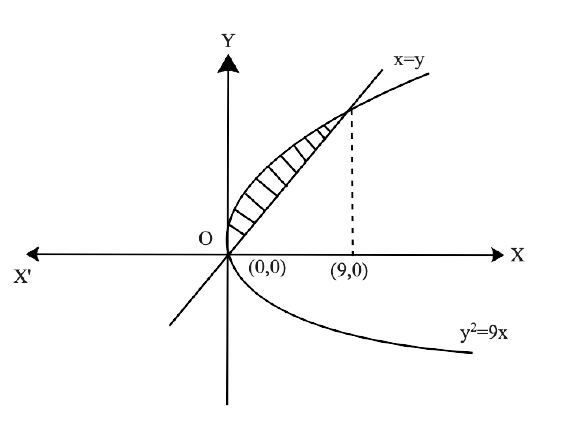
Therefore, area of shaded region A = $\mathop{\int }_{0}^{9}$($\sqrt{9x}$ - x ) dx
= $\mathop{\int }_{0}^{9}$(3$\sqrt{x}$ - x ) dx
= $\mathop{\int }_{0}^{9}$(3$\sqrt{x}$ ) dx - $\mathop{\int }_{0}^{9}$( x ) dx
= $\left[ \frac{6~{{x}^{\frac{3}{2}}}}{3}-\frac{{{x}^{2}}}{2} \right]_{0}^{9}$
= ( 6.$\frac{{{9}^{\frac{3}{2}}}}{3}$-$\frac{81}{2}-0)$
= 54 -$\frac{81}{2}$
= $\frac{108-81}{2}$
= $\frac{27}{2}$ sq units
6. Find the area of the region enclosed by the parabola ${{x}^{2}}$ = y and the line
y = x + 2.
Ans: We have, ${{x}^{2}}$ = y and y = x + 2
$\Rightarrow $ ${{x}^{2}}$ = x +2
$\Rightarrow $ ${{x}^{2}}$ -( x +2) = 0
$\Rightarrow $ ${{x}^{2}}$ -x -2 = 0
$\Rightarrow $ ${{x}^{2}}$ -2 x + x -2 = 0
$\Rightarrow $ x (x - 2) + 1(x - 2) = 0
$\Rightarrow $ (x +1) ( x - 2) = 0
$\Rightarrow $ x = -1, 2
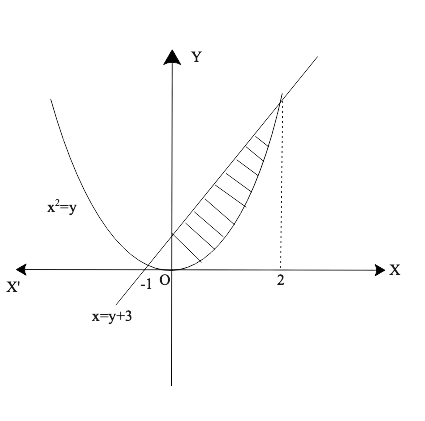
Therefore, area of shaded region A = $\mathop{\int }_{-1}^{2}$( x + 2 - ${{x}^{2}}$ ) dx
= $\left[ \frac{{{x}^{2}}}{2}+~2~x-\frac{{{x}^{3}}}{3} \right]_{-1}^{2}$
= [$\frac{4}{2}+4-~\frac{8}{3}-\frac{1}{2}$+ 2 -$\frac{1}{3}]$
= (8 - 3 - $\frac{1}{2}$) = $\frac{9}{2}$ sq units
7. Find the area of region bounded by the line x = 2 and the parabola ${{y}^{2}}$ = 8x .
Ans: We have, ${{y}^{2}}$ = 8x and x = 2.
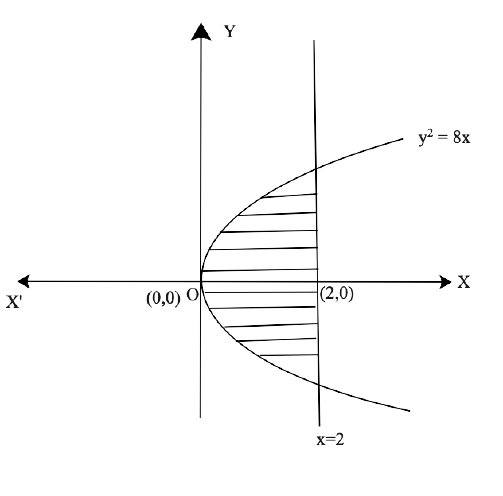
Therefore, area of shaded region A = 2 $\mathop{\int }_{0}^{2}$($\sqrt{8x}$ ) dx
= 2. 2$\sqrt{2}$ $\mathop{\int }_{0}^{2}$($\sqrt{x}$ ) dx
= 4 .$\sqrt{2}$ $\left[ \frac{2~{{x}^{\frac{3}{2}}}}{3} \right]_{0}^{2}$
= 4 .$\sqrt{2}$ [$\frac{2~{{.2}^{\frac{3}{2}}}}{3}$]
= $\frac{32}{3}$ sq units
8. Sketch the region {(x, 0) : y = $\sqrt{4~-{{x}^{2}}}$} and x-axis. Find the area of the region using integration.
Ans: Given region is {(x, 0) : y = $\sqrt{4~-{{x}^{2}}}$} and x-axis
We have, y = $\sqrt{4~-{{x}^{2}}}$
$\Rightarrow $ ${{y}^{2}}$ = 4 - ${{x}^{2}}$
$\Rightarrow $ ${{y}^{2}}$ + ${{x}^{2}}$ = 4
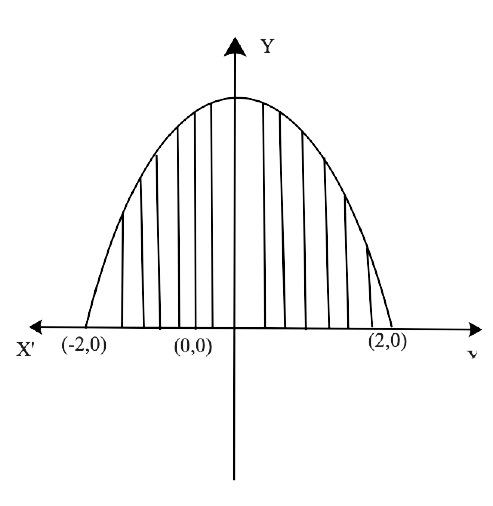
Therefore, area of shaded region A = $\mathop{\int }_{-2}^{2}$($\sqrt{4~-{{x}^{2}}}$ ) dx
= $\mathop{\int }_{-2}^{2}$($\sqrt{{{2}^{2}}-{{x}^{2}}}$ ) dx
= $\left[ \frac{x}{2}\sqrt{{{2}^{2}}-{{x}^{2}}}+~\frac{{{2}^{2}}}{2}si{{n}^{-1}}\frac{x}{2} \right]_{-2}^{2}$
= $\frac{2}{2}$.0 + 2 . $\frac{\pi }{2}$+ $\frac{2}{2}.0$ - 2 $si{{n}^{-1}}$(-1)
= 2 . $\frac{\pi }{2}$ + 2 . $\frac{\pi }{2}$
= 2 $\pi $ sq units
9. Calculate the area under the curve y = 2 $\sqrt{x}$ included between the lines
x = 0 and x = 1.
Ans: We have, y = 2 $\sqrt{x}$ , x =0 and x = 1.
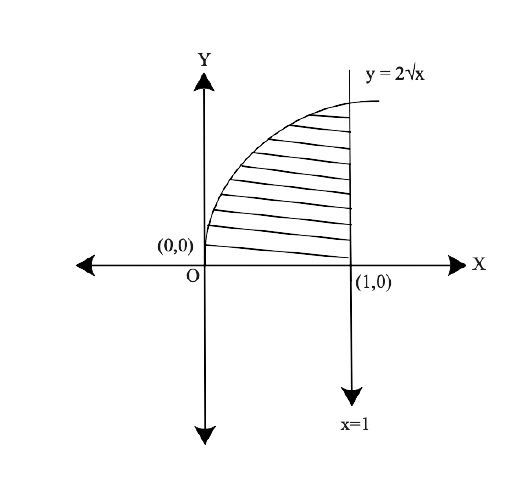
Therefore, area of shaded region A = $\mathop{\int }_{0}^{1}$(2$\sqrt{x}$ ) dx
= 2 $\left[ \frac{2~{{x}^{\frac{3}{2}}}}{3} \right]_{0}^{1}$
= 2 ($\frac{2}{3}.1$-0)
= $\frac{4}{3}$ sq units
10. Using integration, find the area of the region bounded by the line
2y = 5x + 7, x- axis and the lines x = 2 and x = 8.
Ans: We have 2 y = 5 x +7
$\Rightarrow $ y= $\frac{5x}{2}+$ $\frac{7}{2}$
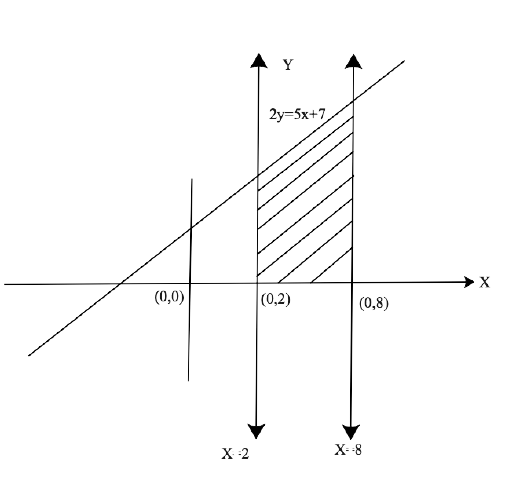
Area of shaded region = $\frac{1}{2}\mathop{\int }_{2}^{8}\left( 5x~+7 \right)~dx$
= $\frac{1}{2}\left[ \frac{5{{x}^{2}}}{2}+7x \right]_{2}^{8}$
= $\frac{1}{2}$[$\frac{5{{\left( 8 \right)}^{2}}}{2}$ + 7(8) -$\frac{5{{\left( 2 \right)}^{2}}}{2}$-7(2)]
= 96 sq units
11. Draw a rough sketch of the curve y =$\sqrt{x~-~1~}$ in the interval [1, 5]. Find the area under the curve and between the lines x = 1 and x = 5.
Ans: Given equation of the curve is y = $\sqrt{x~-~1~}$
$\Rightarrow ~{{y}^{2}}$ = x- 1
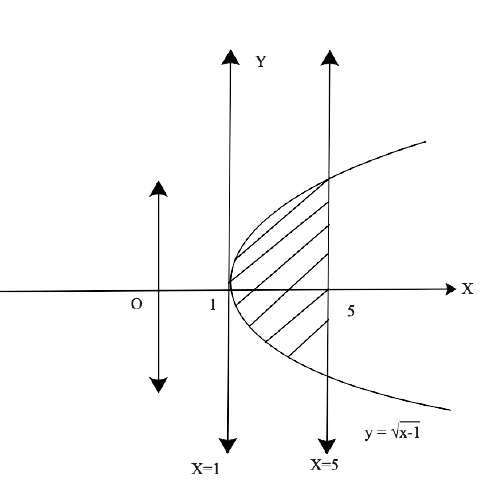
Therefore, area of shaded region A = $\mathop{\int }_{1}^{5}$($\sqrt{x~-1}$ ) dx
= $\left[ \frac{2~{{\left( x-1 \right)}^{\frac{3}{2}}}}{3} \right]_{1}^{5}$
= ($\frac{2}{3}.{{\left( 5-1 \right)}^{\frac{3}{2}}}$-0)
= $\frac{16}{3}$ sq units
12. Determine the area under the curve y = $\sqrt{{{a}^{2}}~-{{x}^{2}}}$ included between the lines x = 0 and x = a.
Ans: Given region is y = $\sqrt{{{a}^{2}}~-{{x}^{2}}}$
$\Rightarrow $ ${{y}^{2}}$ = ${{a}^{2}}$ - ${{x}^{2}}$
$\Rightarrow $ ${{y}^{2}}$ + ${{x}^{2}}$ = ${{a}^{2}}$
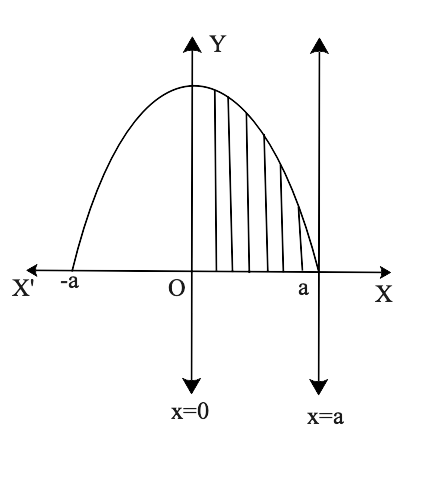
Therefore, area of shaded region A = $\mathop{\int }_{0}^{a}$($\sqrt{{{a}^{2}}~-{{x}^{2}}}$ ) dx
= $\mathop{\int }_{0}^{a}$($\sqrt{{{a}^{2}}~-{{x}^{2}}}$ ) dx
= $\left[ \frac{x}{2}\sqrt{{{a}^{2}}-{{x}^{2}}}+~\frac{{{a}^{2}}}{2}si{{n}^{-1}}\frac{x}{2} \right]_{0}^{a}$
= [ 0 + $\frac{{{a}^{2}}}{2}si{{n}^{-1}}\frac{a}{2}$ -0 - $\frac{{{a}^{2}}}{2}si{{n}^{-1}}0$ ]
= $\frac{{{a}^{2}}}{2}$. $\frac{\pi }{2}$
= $\frac{{{a}^{2}}}{4}$ $\pi $ sq units
13. Find the area of the region bounded by y = $\sqrt{x}$ and y = x.
Ans: Given equations are y = $\sqrt{x}$ and y = x.
$\Rightarrow $ x = $\sqrt{x}$
$\Rightarrow $ ${{x}^{2}}$ = x
$\Rightarrow $ ${{x}^{2}}$ - x =0
$\Rightarrow $ x (x - 1) = 0
$\Rightarrow $ x = 0,1
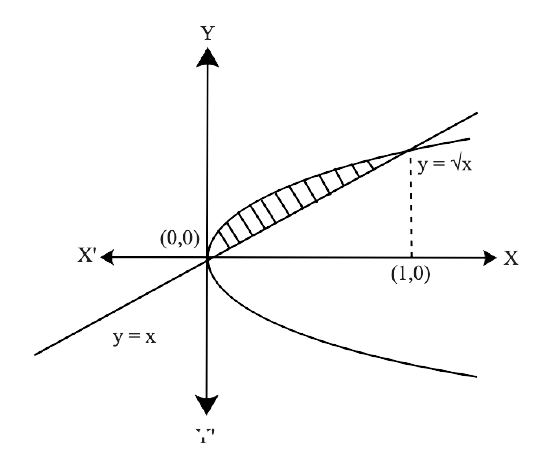
Therefore, area of shaded region A = $\mathop{\int }_{0}^{1}$($\sqrt{x~}$ ) dx - $\mathop{\int }_{0}^{1}$(x ) dx
= $\left[ \frac{2~{{\left( x \right)}^{\frac{3}{2}}}}{3} \right]_{0}^{1}$ - $\left[ \frac{~{{\left( x \right)}^{2}}}{2} \right]_{0}^{1}$
= ($\frac{2}{3}.1$- $\frac{1}{2}$)
= $\frac{2}{3}$-$\frac{1}{2}$
= $\frac{1}{6}$ sq units
14. Find the area enclosed by the curve y = – ${{x}^{2}}$ and the straight line x + y + 2 = 0
Ans: We have ,y = – ${{x}^{2}}$ and the straight line x + y + 2 = 0.
$\Rightarrow $ -x -2 = – ${{x}^{2}}$
$\Rightarrow $ ${{x}^{2}}~-x-2=0$
$\Rightarrow $ ${{x}^{2}}~+x-2x~-2=0$
$\Rightarrow $ x(x+1) - 2(x +1) =0
$\Rightarrow $ (x-2)(x +1) = 0
$\Rightarrow $ x = 2, -1.
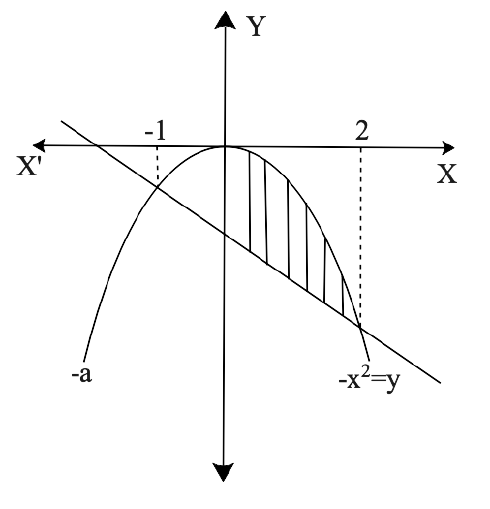
Area of the shaded region = $\left| \mathop{\int }_{-1}^{2}\left( -x~-2~+{{x}^{2}} \right)~dx \right|$
= $\left| \mathop{\int }_{-1}^{2}\left( ~{{x}^{2}}-x~-2 \right)~dx \right|$
= $\left| \left[ \frac{~{{\left( x \right)}^{3}}}{3}-\frac{~{{\left( x \right)}^{2}}}{2}-2x~~ \right] \right|_{-1}^{2}$
= $\left| \left[ \frac{8}{3}-\frac{4}{2}-4~+\frac{1}{3}+\frac{1}{2}-2 \right] \right|$
=$\left| \frac{16-12-24+2+3-12}{6} \right|=\left| \frac{-27}{6} \right|$
$=\frac{9}{2}~sq~units$
15. Find the area bounded by the curve y = $\sqrt{x}$ , x = 2y + 3 in the first quadrant and x- axis.
Ans: Given equation of the curves for y = $\sqrt{x}$ , x = 2y + 3 in the first quadrant.
On solving both the equations for y, we get
y = $\sqrt{2y~+3}$
$\Rightarrow $ ${{y}^{2}}=~2y~+3$
$\Rightarrow $ ${{y}^{2}}-~2y~-3=0$
$\Rightarrow $ ${{y}^{2}}-~3y~+~y~-3=0$
$\Rightarrow $ y (y-3) + 1(y-3) =0
$\Rightarrow $ (y +1) (y-3) =0
$\Rightarrow $ y = -1,3
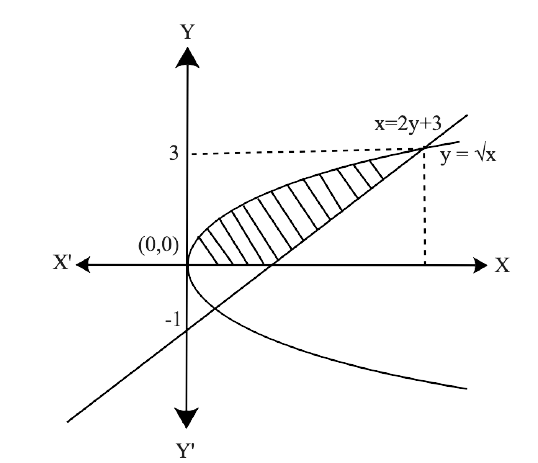
Area of shaded region = $\mathop{\int }_{0}^{3}\left( 2y~+3-~{{y}^{2}} \right)~dy$
= $\left[ \frac{2{{y}^{2}}}{2}+3y~-\frac{{{y}^{3}}}{3} \right]_{0}^{3}$
= [$\frac{18}{2}$ + (9) -9- 0]
= 9 sq units
16. Find the area of the region bounded by the curve ${{y}^{2}}=2x$ and ${{x}^{2}}+{{y}^{2}}=4x$.
Ans: We have ${{y}^{2}}=2x$ and ${{x}^{2}}+{{y}^{2}}=4x$
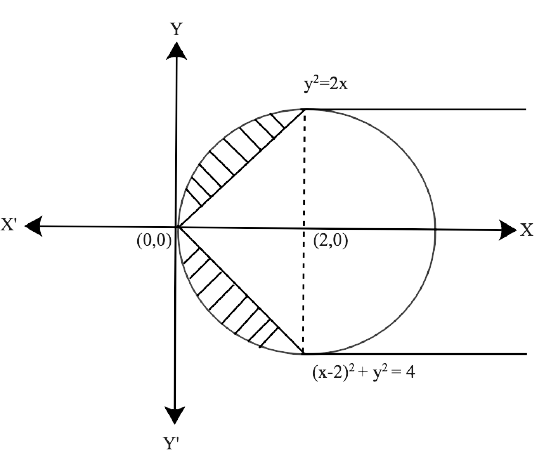
$\Rightarrow {{x}^{2}}+2x=4x$
$\Rightarrow {{x}^{2}}-2x=0$
$\Rightarrow x\left( x-2 \right)=0$
$\Rightarrow x=0$ Or $x=2$
Also, ${{x}^{2}}+{{y}^{2}}=4x$
$\Rightarrow {{x}^{2}}-4x=-{{y}^{2}}$
$\Rightarrow {{x}^{2}}-4x+4=-{{y}^{2}}+4$
$\Rightarrow {{\left( x-2 \right)}^{2}}-{{2}^{2}}=-{{y}^{2}}$
∴ Required area = $2\mathop{\int }_{0}^{2}\left[ \sqrt{{{2}^{2}}-{{\left( x-2 \right)}^{2}}}-\sqrt{2x} \right]dx$
$=2\left[ \left\{ \frac{x~-~2}{2}.\sqrt{{{2}^{2}}-{{\left( x-2 \right)}^{2}}}+\frac{{{2}^{2}}}{2}si{{n}^{-1}}\left( \frac{x~-~2}{2} \right) \right\}_{0}^{2}-\left\{ \sqrt{2}.\frac{{{x}^{\frac{3}{2}}}}{\frac{3}{2}} \right\}_{0}^{2} \right]$
$=2\left[ \left( 0+0-1.0+2.\frac{\pi }{2} \right)-\frac{2\sqrt{2}}{3}\left( {{2}^{\frac{3}{2}}}-0 \right) \right]$
$=\frac{4\pi }{2}-\frac{8~.~2}{3}$
$=2\pi -\frac{16}{3}$
$=2\left( \pi -\frac{8}{3} \right)sq.~units$
17. Find the area bounded by the curve $y=sin~x$ between $x=0$ and $x~=~2\pi $.
Ans: Area of the shaded region = $\mathop{\int }_{0}^{2\pi }\left( sin~x~ \right)~dx$ =$\mathop{\int }_{0}^{\pi }\left( sin~x~ \right)~dx$ + $\left| \mathop{\int }_{\pi }^{2\pi }\left( ~sin~x~ \right)~dx \right|$
= $\left[ -cos~x \right]_{0}^{\pi }+\left| \left[ -cos~x \right]_{\pi }^{2\pi } \right|$
= - [cos $\pi $ - cos 0]+ $\left| -\left[ cos~2\pi -~cos~\pi \right] \right|$
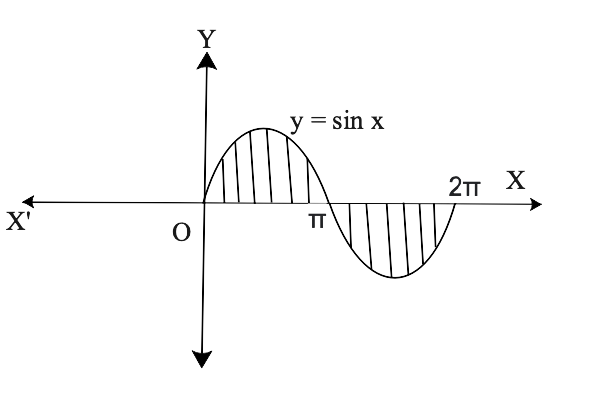
= -[-1-1]+$\left| -\left( 1+1 \right) \right|$
= 2+2 = 4 sq units
18. Find the area of the region bounded by the triangle whose vertices are (–1, 1), (0, 5) and (3, 2), using integration.
Ans: Let we have the vertices of a $\Delta ABC$ as A(–1, 1), B(0, 5) and C(3, 2).
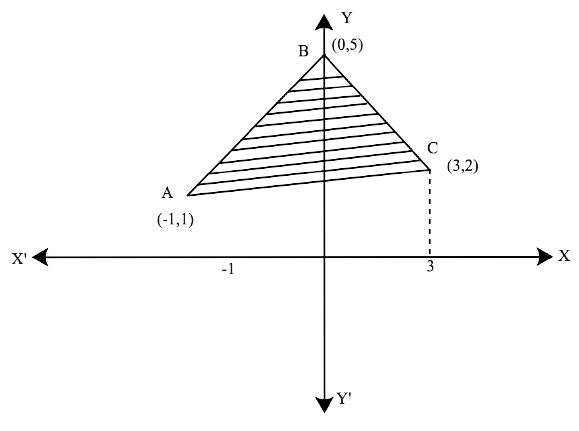
Equation of AB is $y-1=\left( \frac{5~-~1}{0~+~1} \right)\left( x+1 \right)$
$\Rightarrow y-1=4x+4$
$\Rightarrow y=4x+5---\left( i \right)$
And equation of BC is $y-5=\left( \frac{2~-~5}{3~-~0} \right)\left( x-0 \right)$
$\Rightarrow y-5=\frac{-3}{3}\left( x \right)$
$\Rightarrow y=5-x---\left( ii \right)$
Similarly, equation of AC is $y-1=\left( \frac{2~-~1}{3~+~1} \right)\left( x+1 \right)$
$\Rightarrow y-1=\frac{1}{4}\left( x+1 \right)$
$\Rightarrow 4y=x+5---\left( iii \right)$
Area of shaded region $=\mathop{\int }_{-1}^{0}\left( {{y}_{1}}-{{y}_{2}} \right)dx+\mathop{\int }_{0}^{3}\left( {{y}_{1}}-{{y}_{2}} \right)dx$
$=\mathop{\int }_{-1}^{0}\left( 4x+5-\frac{x~+~5}{4} \right)dx+\mathop{\int }_{0}^{3}\left( 5-x-\frac{x~+~5}{4} \right)dx$
$=\left[ \frac{4{{x}^{2}}}{2}+5x-\frac{{{x}^{2}}}{8}-\frac{5x}{4} \right]_{-1}^{~~0}+\left[ 5x-\frac{{{x}^{2}}}{2}-\frac{{{x}^{2}}}{8}-\frac{5x}{4} \right]_{0}^{3}$
$=\left[ 0-\left( \frac{4{{\left( -1 \right)}^{2}}}{2}+5\left( -1 \right)-\frac{{{\left( -1 \right)}^{2}}}{8}-\frac{5\left( -1 \right)}{4} \right) \right]+\left[ 5\left( 3 \right)-\frac{{{3}^{2}}}{2}-\frac{{{3}^{2}}}{8}-\frac{5\left( 3 \right)}{4}-0 \right]$
$=\left[ 0-\left( 2-5-\frac{1}{8}+\frac{5}{4} \right) \right]+\left[ 15-\frac{9}{2}-\frac{9}{8}-\frac{15}{4} \right]$
$=3+\frac{1}{8}-\frac{5}{4}+15-\frac{9}{2}-\frac{9}{8}-\frac{15}{4}$
$=18+\left( \frac{1-10-36-9-30}{8} \right)$
$=18-\frac{84}{8}$
$=18-\frac{21}{2}$
= $\frac{15}{2}sq.~units$
19. Draw a rough sketch of the region {(x, y) : ${{y}^{2}}$ ≤ 6ax and ${{x}^{2}}+{{y}^{2}}\le 16{{a}^{2}}$}. Also find the area of the region sketched using method of integration.
Ans: We have, ${{y}^{2}}=6ax$ and ${{x}^{2}}+{{y}^{2}}=16{{a}^{2}}$
$\Rightarrow {{x}^{2}}+6ax=16{{a}^{2}}$
$\Rightarrow {{x}^{2}}+6ax-16{{a}^{2}}=0$
$\Rightarrow {{x}^{2}}+8ax-2ax-16{{a}^{2}}=0$
$\Rightarrow x\left( x+8a \right)-2a\left( x+8a \right)=0$
$\Rightarrow \left( x-2a \right)\left( x+8a \right)=0$
$\Rightarrow x=2a,~-8a$
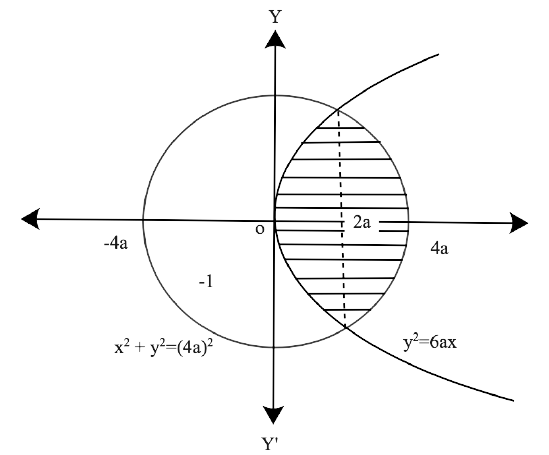
Area of required region = $2\left[ \mathop{\int }_{0}^{2a}\sqrt{6ax}dx+\mathop{\int }_{2a}^{4a}\sqrt{{{\left( 4a \right)}^{2}}-{{x}^{2}}}dx \right]$
$=2\left[ \sqrt{6a}\left[ \frac{{{x}^{\frac{3}{2}}}}{\frac{3}{2}} \right]_{0}^{2a}+\left[ \frac{x}{2}\sqrt{{{\left( 4a \right)}^{2}}-{{x}^{2}}}+\frac{{{(4a)}^{2}}}{2}si{{n}^{-1}}\frac{x}{4a} \right]_{2a}^{4a} \right]$
$=2\left[ \sqrt{6a}\times \frac{2}{3}{{\left( 2a \right)}^{\frac{3}{2}}}+\frac{4a}{2}\left( 0 \right)+\frac{16{{a}^{2}}}{2}\times \frac{\pi }{2}-\frac{2a}{2}\sqrt{16{{a}^{2}}-4{{a}^{2}}}-\frac{16{{a}^{2}}}{2}si{{n}^{-1}}\frac{2a}{4a} \right]$
$=2\left[ \sqrt{6a}\times \frac{2}{3}\times 2\sqrt{2}{{a}^{\frac{3}{2}}}+0+4\pi {{a}^{2}}-a.2\sqrt{3}a-8{{a}^{2}}.\frac{\pi }{6} \right]$
$=2\left[ \sqrt{12}\times \frac{4}{3}{{a}^{2}}+4\pi {{a}^{2}}-2\sqrt{3}{{a}^{2}}-\frac{4{{a}^{2}}\pi }{3} \right]$
$=2\left[ \frac{8\sqrt{3}{{a}^{2}}~+~12\pi {{a}^{2}}~-6\sqrt{3}{{a}^{2}}~-~4{{a}^{2}}\pi }{3} \right]$
$=\frac{2}{3}{{a}^{2}}\left[ 8\sqrt{3}~+~12\pi -6\sqrt{3}-4\pi \right]$
$=\frac{2}{3}{{a}^{2}}\left[ 2\sqrt{3}~+~8\pi \right]$
$=\frac{4}{3}{{a}^{2}}\left[ \sqrt{3}~+~4\pi \right]sq.~units$
20. Compute the area bounded by the lines x + 2y = 2, y – x = 1 and 2x + y = 7.
Ans: We have,
x + 2y = 2 -----(i)
y – x = 1 -----(ii)
and 2x + y = 7 -----(iii)
On solving Eqs. (i) and (ii), we get
$y-\left( 2-2y \right)=1$
$\Rightarrow 3y-2=1$
$\Rightarrow y=1$
From eq. (i)-
$x=2-2\left( 1 \right)=0$
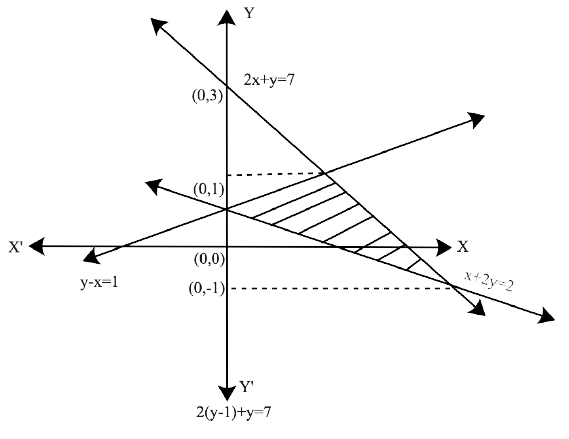
On solving Eqs. (ii) and (iii), we get
$2\left( y-1 \right)+y=7$
$\Rightarrow 2y-2+y=7$
$\Rightarrow 3y=9$
$\Rightarrow y=3$
From eq. (ii)-
$x=3-1=2$
On solving Eqs. (i) and (iii), we get
$2\left( 2-2y \right)+y=7$
$\Rightarrow 4-4y+y=7$
$\Rightarrow -3y=3$
$\Rightarrow y=-1$
From eq. (iii)-
$2x=7-\left( -1 \right)$
$\Rightarrow x=4$
Required area $=\mathop{\int }_{-1}^{3}\frac{7-y}{2}dy-\left[ \mathop{\int }_{-1}^{1}\left( 2-2y \right)dy+\mathop{\int }_{1}^{3}\left( y-1 \right)dy \right]$
$=\frac{1}{2}\left( 7y-\frac{{{y}^{2}}}{2} \right)_{-1}^{3}-\left[ \left( 2y-{{y}^{2}} \right)_{-1}^{1}+\left( \frac{{{y}^{2}}}{2}-y \right)_{1}^{3} \right]$
$=\frac{1}{2}\left( 21-\frac{9}{2}+7+\frac{1}{2} \right)-\left( 2-1+2+1 \right)-\left( \frac{9}{2}-3-\frac{1}{2}+1 \right)$
$=12-4-2=6~sq.~units$
21. Find the area bounded by the lines y = 4x + 5, y = 5 – x and 4y = x + 5.
Ans: Given equations of lines are
y = 4x + 5 -----(i)
y = 5 – x ------(ii)
and 4y = x + 5 -----(iii)
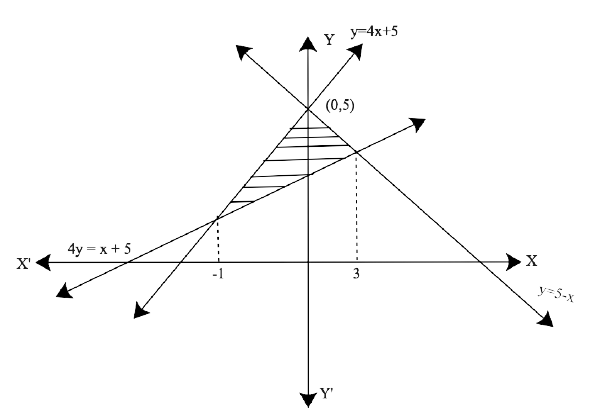
On solving eq (i) and (ii), we get
$4x+5=5-x$
$\Rightarrow 5x=0$
$\Rightarrow x=0$
On solving eq (i) and (iii), we get
$4\left( 4x+5 \right)=5+x$
$\Rightarrow 16x+20=5+x$
$\Rightarrow 15x=-15$
$\Rightarrow x=-1$
On solving eq (ii) and (iii), we get
$4\left( 5-x \right)=5+x$
$\Rightarrow 20-4x=5+x$
$\Rightarrow 15=5x$
$\Rightarrow x=3$
Required area $=\mathop{\int }_{-1}^{0}\left( 4x+5 \right)dx+\mathop{\int }_{0}^{3}\left( 5-x \right)dx-\frac{1}{4}\mathop{\int }_{-1}^{3}\left( x+5 \right)dx$
$=\left[ \frac{4{{x}^{2}}}{2}+5x \right]_{-1}^{0}+\left[ 5x-\frac{{{x}^{2}}}{2} \right]_{0}^{3}-\frac{1}{4}\left[ \frac{{{x}^{2}}}{2}+5x \right]_{-1}^{3}$
$=\left[ 0-2+5 \right]+\left[ 15-\frac{9}{2}-0 \right]-\frac{1}{4}\left[ \frac{9}{2}+15-\frac{1}{2}+5 \right]$
$=3+\frac{21}{2}-\frac{1}{4}\times 24$
$=-3+\frac{21}{2}=\frac{15}{2}sq.~units$
22. Find the area bounded by the curve y = 2cosx and the x-axis from x = 0 to x = 2π.
Ans:
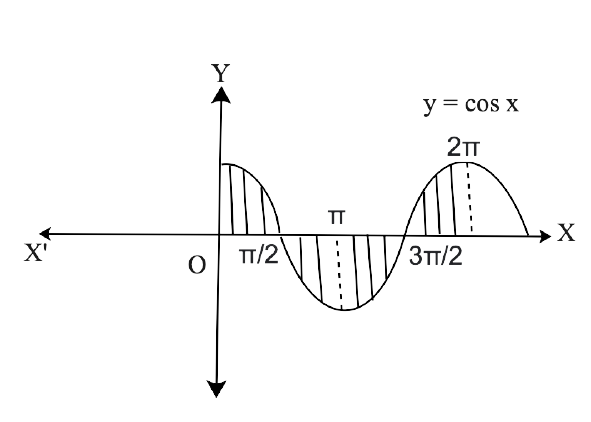
Required area of shaded region $=\mathop{\int }_{0}^{2\pi }2cos~xdx$
$=\mathop{\int }_{0}^{\frac{\pi }{2}}2cos~xdx+\left| \mathop{\int }_{\frac{\pi }{2}}^{\frac{3\pi }{2}}2cos~xdx \right|+\mathop{\int }_{\frac{3\pi }{2}}^{2\pi }2cos~xdx$
$=2\left[ sin~x \right]_{0}^{\frac{\pi }{2}}+\left| 2\left[ sin~x \right]_{\frac{\pi }{2}}^{\frac{3\pi }{2}} \right|+2\left[ sin~x \right]_{\frac{3\pi }{2}}^{2\pi }$
$=2\left( 1-0 \right)+\left| 2\left( -1-1 \right) \right|+2\left( 0+1 \right)$
$=2+4+2=8~sq.~units$
23. Draw a rough sketch of the given curve y = 1 + |x +1|, x = –3, x = 3, y = 0 and find the area of the region bounded by them, using integration.
Ans: We have, $y=1+\left| x+1 \right|,~x=-3,~x=3,y=0$
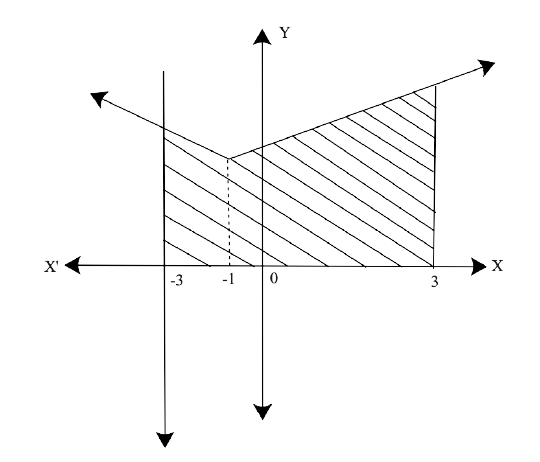
$y=\left\{ _{x~+~2~,~if~x~\ge ~-1}^{-x~,~~~if~x~<~-1} \right\}$
Area of shaded region, $A=\mathop{\int }_{-3}^{-1}-xdx+\mathop{\int }_{-1}^{3}\left( x+2 \right)dx$
$=-\left[ \frac{{{x}^{2}}}{2} \right]_{-3}^{-1}+\left[ \frac{{{x}^{2}}}{2}+2x \right]_{-1}^{3}$
$=-\left[ \frac{1}{2}-\frac{9}{2} \right]+\left[ \frac{9}{2}+6-\frac{1}{2}+2 \right]$
$=-\left( -4 \right)+\left( 8+4 \right)$
$=4+12=16~sq.~units$
ChoosethecorrectanswerfromthegivenfouroptionsineachoftheExercises24to34.
24. The area of the region bounded by the y- axis, y = cos x and y = sin x ,
0 $\le x~\le ~\frac{\pi }{2}$ is
(A) $\sqrt{2}$ sq units
(B) ($\sqrt{2}$ + 1 ) sq units
(C) ($\sqrt{2}$ - 1 ) sq units
(D) ($2\sqrt{2}$ - 1 ) sq units
Ans: We have , y-axis i.e x =0 , y= cos x and y = sin x , where 0 $\le x~\le ~\frac{\pi }{2}$
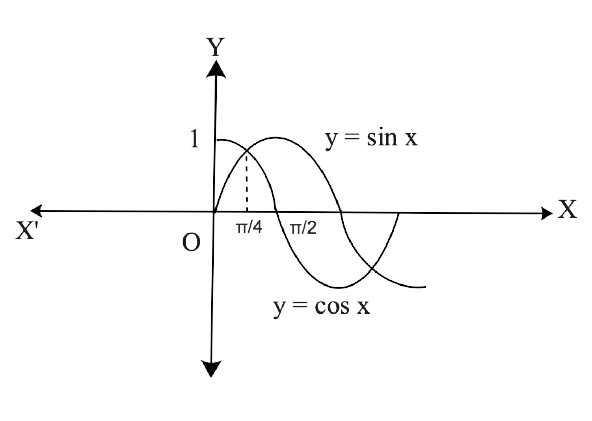
Therefore, required area = $\mathop{\int }_{0}^{\frac{\pi }{4}}\left( cos~x~-~~sin~x \right)~dx$
= $\left[ sin~x \right]_{0}^{\frac{\pi }{4}}+\left[ ~cos~x \right]_{0}^{\frac{\pi }{4}}~$
= (sin $\frac{\pi }{4}$ - sin 0 ) + (cos $\frac{\pi }{4}$ - cos 0)
= ($\frac{1}{\sqrt{2}}-0)~+~(\frac{1}{\sqrt{2}}$ - 1)
= $\frac{2}{\sqrt{2}}-~1$
= ($\sqrt{2}$ - 1) sq units
25. The area of the region bounded by the curve ${{x}^{2}}=~4y~$and the straight line x = 4y - 2 is
(A) $\frac{3}{8}~sq~units$
(B) $\frac{5}{8}~sq~units$
(C) $\frac{7}{8}~sq~units$
(D) $\frac{9}{8}~sq~units$
Ans: Given equation of curve is ${{x}^{2}}=~4y$ and the straight line x = 4y - 2
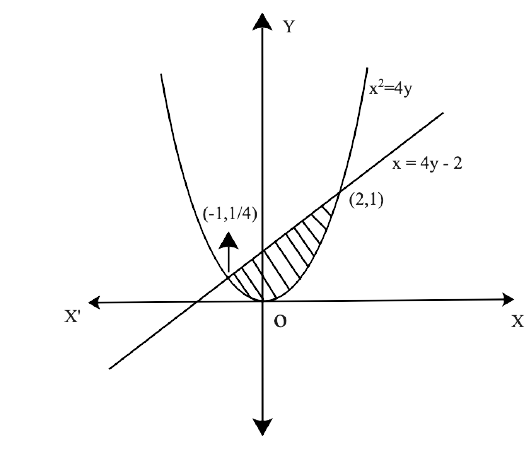
For intersection point , put x = 4y -2 in equation of curve , we get
${{\left( 4y~-~2 \right)}^{2}}~=~4~y~$
$\Rightarrow $ 16 ${{y}^{2}}$ + 4 - 16 y = 4y
$\Rightarrow $ 16 ${{y}^{2}}$ -20 y +4 = 0
$\Rightarrow $ 4 ${{y}^{2}}$ -5 y +1 = 0
$\Rightarrow $ 4 ${{y}^{2}}$ -4 y - y +1 = 0
$\Rightarrow $ 4 y(y-1) - 1(y - 1) = 0
$\Rightarrow $ (4y - 1)(y-1) =0
Therefore, y = 1, $\frac{1}{4}$
For y = 1, x = $\sqrt{4.1}$ = 2 [since , negative value does not satisfy the equation of line]
For y = $\frac{1}{4}$, x = $\sqrt{4~.\frac{1}{4}~}$= -1 [ positive value does not satisfy the equation of line]
So, the intersection points are (2,1) and (-1, $\frac{1}{4}$).
Therefore, area of shaded region = $\mathop{\int }_{-1}^{2}$($\frac{x+~2}{4})$dx - $\mathop{\int }_{-1}^{2}\frac{{{x}^{2}}}{4}dx$
= $\frac{1}{4}\left[ \frac{{{x}^{2}}}{2}~+2x~ \right]_{-1}^{2}-~\frac{1}{4}\left| \frac{{{x}^{3}}}{3} \right|_{-1}^{2}$
= $\frac{1}{4}$($\frac{4}{2}+4~-\frac{1}{2}+2)-~\frac{1}{4}~\left( \frac{8}{3}+\frac{1}{3} \right)$
= $\frac{1}{4}$.$\frac{15}{2}~-~\frac{1}{4}.\frac{9}{3}$
= $\frac{9}{8~}~sq~units$
26. The area of the region bounded by the curve y = $\sqrt{16~-{{x}^{2}}~}$ and
x - axis is:
(A) 8 $\pi $ sq. units
(B) 20 $\pi $ sq. units
(C) 16 $\pi $ sq. units
(D) 256 $\pi $ sq. units
Ans: Given equation of curve is y = $\sqrt{16~-{{x}^{2}}~}$and the equation of line is x - axis i.e , y = 0.
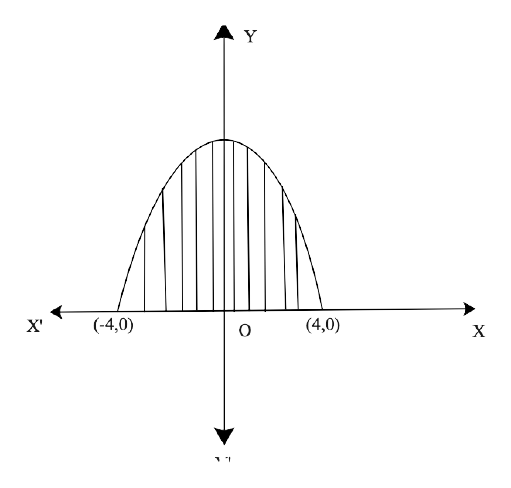
Therefore $\sqrt{16~-{{x}^{2}}}$ = 0
$\Rightarrow $ 16 - ${{x}^{2}}$= 0
$\Rightarrow $ ${{x}^{2}}$= 16
$\Rightarrow $ x = $\pm $4
So, the intersection points are (4,0) and (-4,0).
Therefore, area of curve, A = $\mathop{\int }_{-4}^{4}{{\left( 16~-~{{x}^{2}} \right)}^{\frac{1}{2}}}$ dx
= $\mathop{\int }_{-4}^{4}{{\left( ~{{4}^{2}}-~{{x}^{2}} \right)}^{\frac{1}{2}}}$ dx
= $\left[ \frac{x}{2}\sqrt{~{{4}^{2}}-~{{x}^{2}}}~+~\frac{{{4}^{2}}}{2}si{{n}^{-1}}\frac{x}{4} \right]_{-4}^{4}$
= $[\frac{4}{2}\sqrt{~{{4}^{2}}-~{{4}^{2}}}~+~\frac{{{4}^{2}}}{2}si{{n}^{-1}}\frac{4}{4}$]-$[\frac{-4}{2}\sqrt{~{{4}^{2}}-~{{(-4)}^{2}}}~+~\frac{{{4}^{2}}}{2}si{{n}^{-1}}\frac{-4}{4}$]
= [2.0 +8 . $\frac{\pi }{2}$-0 + 8 . $\frac{\pi }{2}$]
= 8 $\pi $ sq units
27. Area of the region in the first quadrant enclosed by the x-axis, the line y = x and the circle ${{x}^{2}}+{{y}^{2}}=32~$is
(A) 16π sq units (B) 4π sq units (C) 32π sq units (D) 24 sq units
Ans: We have enclosed by x-axis ie. y = 0, y = x and the circle ${{x}^{2}}+{{y}^{2}}=32$ in the first quadrant.
since, ${{x}^{2}}+{{y}^{2}}=32$ [∵y = x]
$\Rightarrow 2{{x}^{2}}=32$
$\Rightarrow x=\pm 4$
So, the intersection point of circle ${{x}^{2}}+{{y}^{2}}=32$ and line y = x are (4,4) and (4,-4).
And ${{x}^{2}}+{{y}^{2}}={{\left( 4\sqrt{2} \right)}^{2}}$
Since, y = 0,
$\Rightarrow {{x}^{2}}+0={{\left( 4\sqrt{2} \right)}^{2}}$
$\Rightarrow x=\pm 4\sqrt{2}$
So. the circle intersects the x-axis at ($\pm 4\sqrt{2}$, 0)
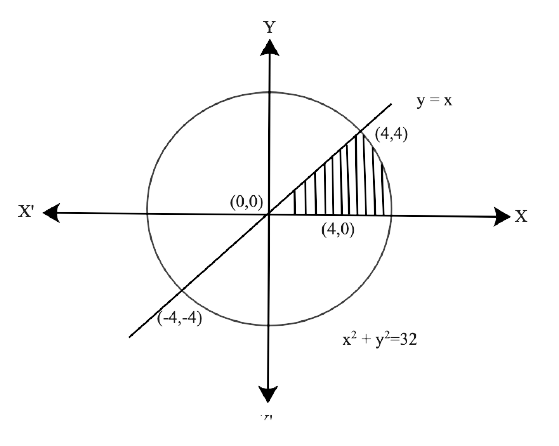
Area of shaded region $=\mathop{\int }_{0}^{4}xdx+\mathop{\int }_{4}^{4\sqrt{2}}\sqrt{{{\left( 4\sqrt{2} \right)}^{2}}-{{x}^{2}}}~dx$
$=\left| \frac{{{x}^{2}}}{2} \right|_{0}^{4}+\left| \frac{x}{2}\sqrt{{{\left( 4\sqrt{2} \right)}^{2}}-{{x}^{2}}}+\frac{{{\left( 4\sqrt{2} \right)}^{2}}}{2}si{{n}^{-1}}\frac{x}{4\sqrt{2}} \right|_{4}^{4\sqrt{2}}$
$=\frac{16}{2}+\left[ \frac{4\sqrt{2}}{2}.0+16si{{n}^{-1}}\frac{4\sqrt{2}}{4\sqrt{2}}-\frac{4}{2}\sqrt{{{\left( 4\sqrt{2} \right)}^{2}}-16}-16si{{n}^{-1}}\frac{4}{4\sqrt{2}} \right]$
$=8+\left( 16.\frac{\pi }{2}-2\sqrt{16}-16.\frac{\pi }{4} \right)$
$=8+8\pi -8-4\pi =4\pi ~sq.units$
28. Area of the region bounded by the curve y = cos x between x = 0 and x = $\pi $ is
(A)2 sq units
(B)4 sq units
(C)3 sq units
(D)1 sq units
Ans: Required area enclosed by the curve y =cos x , x =0 and x = $\pi $.
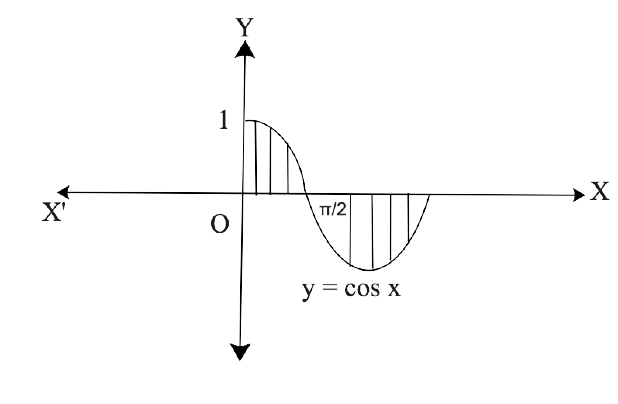
A= $\mathop{\int }_{0}^{\frac{\pi }{2}}cos~x~dx~+~\left| \mathop{\int }_{\frac{\pi }{2}}^{\pi }cos~x~dx \right|$
= [ sin $\frac{\pi }{2}$ - sin 0 ] + $\left| sin~\frac{\pi }{2}~-~sin~\pi ~ \right|$
= 1 + 1 = 2 sq units
29.The area of the region bounded by parabola ${{y}^{2}}$= x and the straight line 2y = x is
(A)$\frac{4}{3~}~sq~units$
(B)$1~sq~units$
(C)$\frac{2}{3~}~sq~units$
(D)$\frac{1}{3~}~sq~units$
Ans: We have to find the area enclosed by parabola ${{y}^{2}}$= x and the straight line 2y = x.
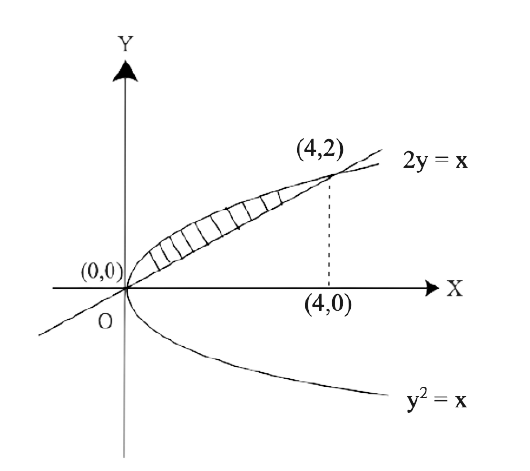
Therefore , ${{\left( \frac{x}{2} \right)}^{2}}=~x$
$\Rightarrow $ ${{x}^{2}}~=~4~x~$
$\Rightarrow $ x(x - 4) =0
$\Rightarrow $ x = 4 $\Rightarrow $ y = 2 and x = 0 $\Rightarrow $ y =0
So, the intersection points are (0,0) and (4,2).
Area enclosed by shaded region,
A = $\mathop{\int }_{0}^{4}\left[ \sqrt{x}-\frac{x}{2} \right]~dx$
= $\left[ \frac{{{x}^{\frac{1}{2}+1}}}{\frac{1}{2}+1}~-~\frac{1}{2}.\frac{{{x}^{2}}}{2} \right]_{0}^{4}$
= $\left[ 2\frac{{{x}^{\frac{3}{2}}}}{3}~-~\frac{{{x}^{2}}}{4} \right]_{0}^{4}$
= $\frac{2}{3}$ $4{{~}^{\frac{3}{2}}}$ -$\frac{16}{4}$- $\frac{2}{3}.0~+~\frac{1}{4}$. 0
=$\frac{16}{3}-\frac{16}{4}$
= $\frac{64-~48}{12}=~\frac{16}{12}=~\frac{4}{3}~sq~units$
30. The area of the region bounded by the curve y = sin x between the ordinates x = 0 , x = $\frac{\pi }{2}$ and the x - axis is
(A)2 sq units
(B)4 sq units
(C)3 sq units
(D)1 sq units
Ans: Area of the region bounded by the curve y = sin x between between the ordinates x = 0, x= $\frac{\pi }{2}$ and x - axis is
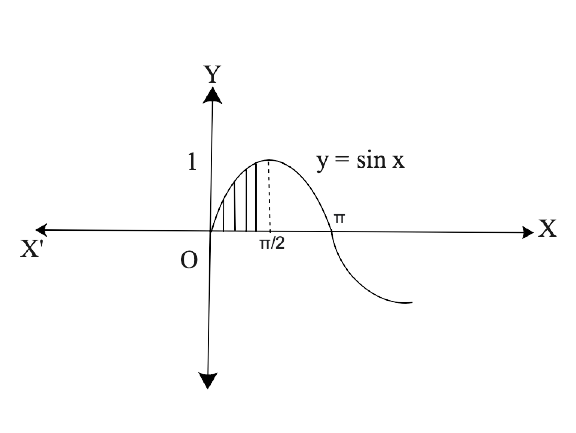
A = $\mathop{\int }_{0}^{\frac{\pi }{2}}$sin x dx
= -$~\left[ ~cos~x~ \right]_{0}^{\frac{\pi }{2}}$ = -[ cos $\frac{\pi }{2}$ - cos 0]
= -[0-1] = 1 sq unit
31. The area of the region bounded by the ellipse $\frac{{{x}^{2}}}{25}+$ $\frac{{{y}^{2}}}{16}$ = 1 is
(A) 20 $\pi $ sq units
(B) 20 ${{\pi }^{2}}~sq~units$
(C) 16 ${{\pi }^{2}}~sq~units$
(D) 25 $\pi $ sq units
Ans: We have , $\frac{{{x}^{2}}}{{{5}^{2}}}+$ $\frac{{{y}^{2}}}{{{4}^{2}}}$ = 1
Here, a = $\pm 5~$and b = $\pm 4$
And , $\frac{{{y}^{2}}}{{{4}^{2}}}$= 1-$\frac{{{x}^{2}}}{{{5}^{2}}}$
$\Rightarrow $ ${{y}^{2}}$ = 16 (1-$\frac{{{x}^{2}}}{{{5}^{2}}}$)
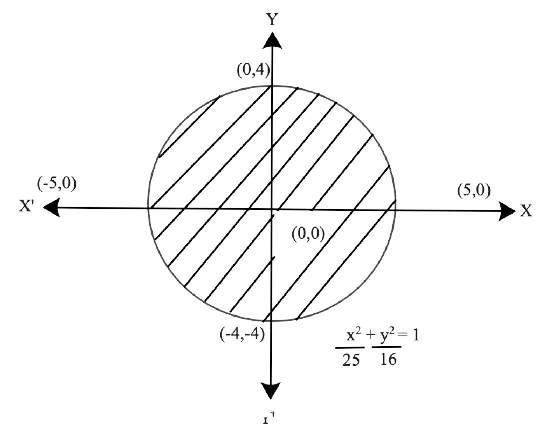
$~~~~~\Rightarrow $ ${{y}^{2}}$ = 16 (1-$\frac{{{x}^{2}}}{{{5}^{2}}}$)
$\Rightarrow $ y = $\sqrt{16~\left( 1-\frac{{{x}^{2}}}{{{5}^{2}}} \right)}$
$\Rightarrow $ y = $\frac{4}{5}\sqrt{{{5}^{2}}-{{x}^{2}}}$
Area enclosed by ellipse , A = 2 . $\frac{4}{5}$ $\mathop{\int }_{-5}^{5}\sqrt{{{5}^{2}}-{{x}^{2}}}$ dx
= 2 . $\frac{8}{5}$ $\mathop{\int }_{0}^{5}\sqrt{{{5}^{2}}-{{x}^{2}}}$ dx
= 2.$\frac{8}{5}$ $\left[ \frac{x}{2}~\sqrt{{{5}^{2}}-{{x}^{2}}}~~+\frac{{{5}^{2}}}{2}si{{n}^{-1}}\frac{x}{5}~ \right]_{0}^{5}$
= 2.$\frac{8}{5}$ [ $\frac{5}{2}~\sqrt{{{5}^{2}}-{{5}^{2}}}~~+\frac{{{5}^{2}}}{2}si{{n}^{-1}}\frac{5}{5}~-0~-\frac{25}{2}.0]~$
= 2.$\frac{8}{5}$ [ $\frac{25}{2}$.$\frac{\pi }{2}]$
= $\frac{16}{5}$.$\frac{25~\pi }{4}$
= $20~\pi $ sq units
32. The area of the region bounded by the circle ${{x}^{2}}$ + ${{y}^{2}}$ = 1 is
(A) 2π sq units (B) π sq units (C) 3π sq units (D) 4π sq units
Ans: We have , ${{x}^{2}}$ + ${{y}^{2}}$ = 1 [ Since, r = $\pm ~1$ ]
$\Rightarrow $ ${{y}^{2}}$ = 1 -${{x}^{2}}$
$\Rightarrow $ y = $\sqrt{1~-{{x}^{2}}}$
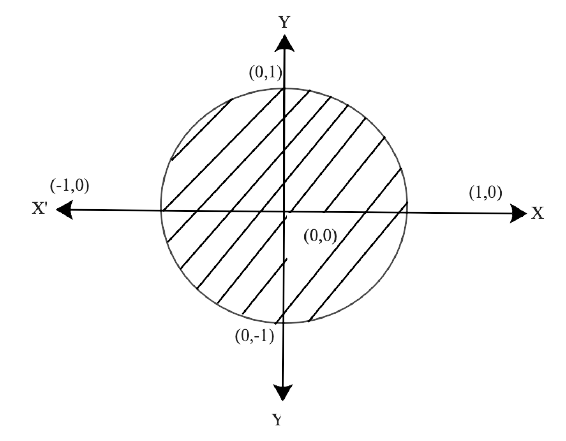
Therefore, area enclosed by circle = 2 $\mathop{\int }_{-1}^{1}\sqrt{{{1}^{2}}-{{x}^{2}}~}$ dx
= 2. 2 $\mathop{\int }_{0}^{1}\sqrt{{{1}^{2}}-{{x}^{2}}~}$ dx
= 2.2 $[\frac{x}{2}_{{}}^{{}}\sqrt{{{1}^{2}}-{{x}^{2}}}~+~\frac{{{1}^{2}}}{2}~si{{n}^{-1}}x]_{0}^{1}$
= 4 [ $\frac{1}{2}.0$+ $\frac{1}{2}$.$\frac{\pi }{2}$-0-$\frac{1}{2}$.0]
= 4 .$\frac{\pi }{4}$ = $\pi $ sq units
33. The area of the region bounded by the curve y = x + 1 and the lines
x = 2 and x = 3 is
(A) $\frac{7}{2}$ sq units (B) $\frac{9}{2}$ sq units (C) $\frac{11}{2}$ sq units (D) $\frac{13}{2}$ sq units
Ans: Required area , A = $\mathop{\int }_{2}^{3}\left( x~+~1 \right)~dx$
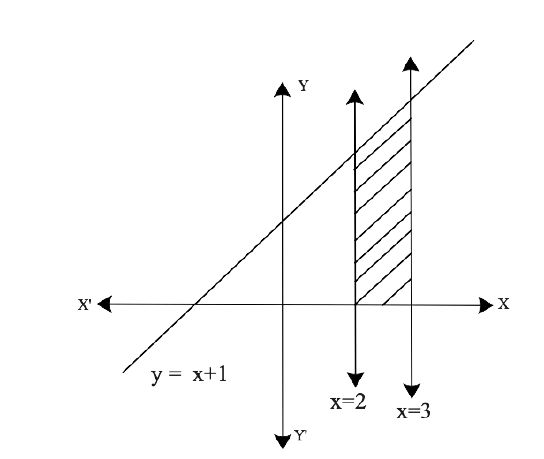
$\Rightarrow $ $\left[ \frac{~{{x}^{2}}}{2}~+~x~ \right]_{2}^{3}$
$\Rightarrow $ $\left[ \frac{9}{2}+~3~-\frac{4}{2}~-~2~ \right]_{{}}^{{}}$
$\Rightarrow $ $\frac{7}{2}$ sq units
34. The area of the region bounded by the curve x = 2y + 3 and the y lines. y = 1 and y = –1 is
(A) 4 sq units (B) $\frac{3}{2}$ sq units (C) 6 sq units (D) 8 sq units
Ans: Required area , A = $\mathop{\int }_{-1}^{1}\left( 2y~+~3 \right)~dy$
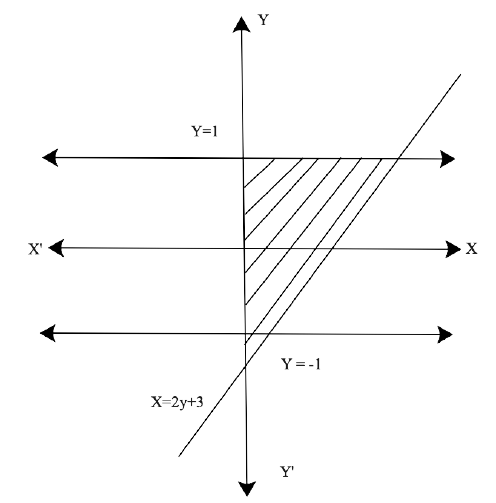
$\Rightarrow $ $\left[ \frac{2~{{y}^{2}}}{2}~+~3~y~ \right]_{-1}^{1}$
$\Rightarrow $ $\left[ ~~{{y}^{2}}+~3~y~ \right]_{-1}^{1}$
$\Rightarrow $ $\left[ ~1~+~3~-1~+~3~ \right]_{{}}^{{}}$
$\Rightarrow $ 6 sq. units
Exemplar for Chapter 8 Application of Integrals
Chapter 8 - Application of Integrals for Class 12 focuses on the Application Of Integrals. Students will get notes, additional questions, sample papers, and last year’s Exam papers attached to the Exemplar. Chapter 8 - Application Of Integrals is based on the Application Of Integrals with the method of finding the area under the simple curves, a line and an area between two curves, and the area region bounded by a curve. The students following the Exemplar step by step can easily clear their doubts and understand the steps used in solving the problems.
The PDF of the Exemplar for Chapter 8 Applicationof Integrals is available for free at Vedantu. Vedantu offers notes, sample question papers, additional questions, and last year’s questions for the same. The online study material available at Vedantu has quality content which is checked by the group members of the expert faculty. Students also can join online Classes for the subject so that they can revise the concepts and topics, and can clear their doubts. As Class 12 is the final Class for a student’s school life, all the Chapters are important for a student. Students can use this Exemplar for testing their knowledge.
Students can reach out to the official site of Vedantu for the other important study material related to other Chapters. Also, they can register themselves at the website for further notifications.
FAQs on NCERT Exemplar for Class 12 Maths - ApplicationOf Integrals - Free PDF Download
1. Where can students find the Exemplar PDF for Chapter 8 Application of Integrals, Class 12?
Students can find the Exemplar PDF for Chapter 8 Application Of Integrals, Class 12at Vedantu’s official website i.e. vedantu.com. The Exemplar is available for the students to practice and revise the concepts. This PDF will enhance the advanced knowledge of the respective subject which is important from the Exam’s point of view. The Exemplar PDF consists of problems and additional questions that give an efficient preparation for the students to boost their scores in the Examinations.
2. Why is NCERT Exemplar for Class 12 Maths - ApplicationOf Integrals - Free PDF Download important for the preparation for the subject?
Exemplars are important for the preparation for the subject because Exemplar gives another perspective to the students that help them to realize their plus and minus, which is directly related to their score in the Exam. Students constantly following the Exemplar will notice the change in the question-solving pattern and recognize the concepts they have met earlier but found them tough.
3. How is NCERT Exemplar for Class 12 Maths - ApplicationOf Integrals - Free PDF Download designed for the students of Class 12?
Exemplars are designed in such a way for the students of Class 12 that they can boost their preparation that increases their marks in the Exams directly. The Exemplars help students to attain the utmost knowledge about their respective topic which increases their thinking process and has the upper hand compared to other students. Also, the Exemplar is designed by the expert faculty of Vedantu on the latest guidelines and syllabus pattern advised by the Central Board of Secondary education.
4. Is Chapter 8- Application of Integrals important for a Class 12 student?
Yes, Chapter 8- Application of Integrals is important for a Class 12 student as this Chapter has a good marks weightage in Exams. Chapter 8 - Application of Integrals is based on the Application of Integrals with the method of finding the area under the simple curves, a line and an area between two curves, and the area region bounded by a curve. The NCERT Exemplar for Class 12 Maths, Chapter 8 Application of Integrals has been developed and designed in such a manner that will increase the thinking process of students to solve the Exercises related to the Chapter.







































